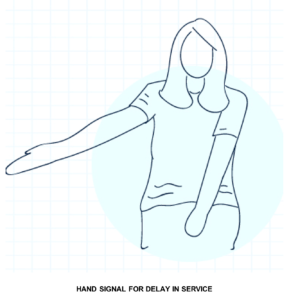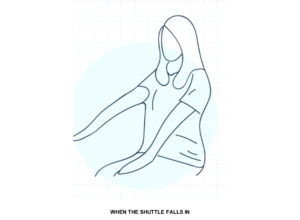Understanding Badminton hand signals and their meaning is necessary if you want to compete in a tournament.
During a tournament, an umpire watches over every match to make sure that the laws of Badminton are being followed and respected.
It is his responsibility to call out a player if they make a fault during play. These faults are indicated by hand signals.
So what are these hand signals?

DELAY IN SERVICE
If a player delays his/her service unnecessarily, the umpire will call it a fault. Once a player raises his/her racket head backwards and then causes a delay, this signal is shown. In Badminton, once the player starts the swing of his/her racket head, it is considered that the service has begun. No delays after this are allowed.
A correct service is when a player does a service in one smooth and continuous motion. Any stops during service will be called out.

FEET PLACED ON SERVICE LINES / OFF THE GROUND
At all times during a service, a player’s feet must always be within the lines of the court. If his/her leg touches the lines, it is called a fault. Also, while serving, a player’s feet must be firmly planted on the ground. Dragging one’s feet is not allowed. At the most lifting your heel/ankle is allowed.
In the event any of these faults are made by a player, the umpire will stretch out his right leg and hand as indicated in the image above one’s feet is not allowed. At the most lifting your heel/ankle is allowed.

SERVICE TOO HIGH
This is one fault many players make. Even at the international level matches, you’ll find the umpire calling this fault quite often. The rule of service is that it should be below the player’s waist. To be specific, the whole shuttle has to be to 1.15 metres from the surface of the court at the instant of being hit by the server’s racket. Anything above this height is called out as a fault.

FACE OF THE RACKET SHOULD BE DOWN WHILST SERVING
During a service, the server should keep in mind that the face of his/her racket should always be pointing downwards. If the racket handle is facing in an upward direction during service the umpire will call this fault.

WHEN THE SHUTTLE LANDS OUT
In a match, there are many instances where you might have seen the umpire or line judge spread their arms out parallel to the ground. This indicates that the shuttle has landed out. This signal is quite important as if the umpire/ line judge doesn’t show this signal at the appropriate time, it can cause of lot of confusion during a match. Also, viewers at home will get a better understanding of where the shuttle landed.

WHEN SHUTTLE LANDS INSIDE
During play if the shuttle lands within the lines or even on the line of the court, the umpire/line judge will confirm the same with the above shown signal. This signal is important as player’s rely a lot on this to determine whether the shot they hit was out or not.
The above images depict the most basic and frequently used hand signals. It is good to familiarize yourself with these signals as it will come in handy when you play a match or even if you are watching a match on TV. Not knowing these signals can leave you confused during a match.
